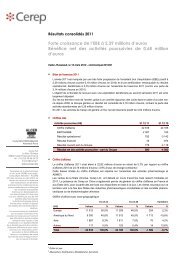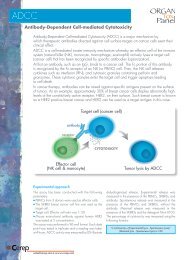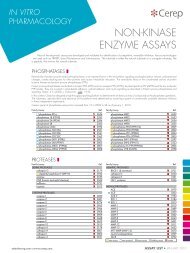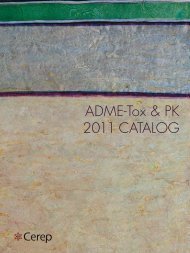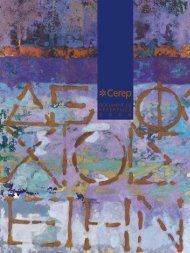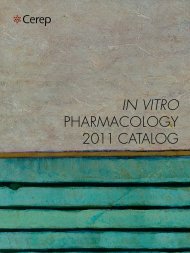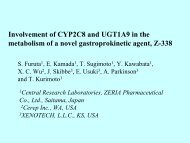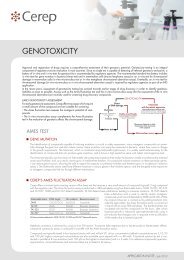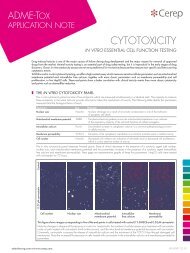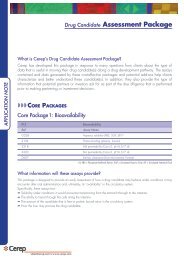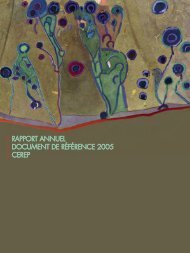in vitro PHARMACOLOGY 2011 CATALOG - Cerep
in vitro PHARMACOLOGY 2011 CATALOG - Cerep
in vitro PHARMACOLOGY 2011 CATALOG - Cerep
Create successful ePaper yourself
Turn your PDF publications into a flip-book with our unique Google optimized e-Paper software.
neuropeptide y ❚<br />
57<br />
Y 1<br />
cellul ar<br />
Ref. 2206<br />
Ref. 2207<br />
Q 3 weeks<br />
Agonist effect<br />
Antagonist effect<br />
Source<br />
SK-N-MC cells (endogenous)<br />
Measured product cAMP<br />
Detection method HTRF<br />
Agonist effect Control NPY (10 nM)<br />
Reference NPY (EC 50 : 0.25 nM)<br />
Antagonist effect Stimulant NPY (1 nM)<br />
Reference BIBP 3226 (IC 50 : 125 nM)<br />
Wieland, H.A. et al. (1995) J. Pharmacol. Exp. Ther., 275: 143-149.<br />
<br />
<br />
<br />
<br />
<br />
<br />
<br />
<br />
<br />
<br />
<br />
[Solvent] must be kept 0.3%<br />
<br />
<br />
<br />
<br />
<br />
<br />
<strong>Cerep</strong><br />
services<br />
<br />
Receptors<br />
[GPCRs]<br />
Y 1<br />
tissue<br />
Ref. 0324<br />
Q 4 weeks<br />
Source<br />
rabbit vas deferens (field-stimulated)<br />
Agonist [Leu 31 ,Pro 34 ]-NPY (pD 2 = 8.1)<br />
Antagonist BIBP 3226<br />
Test concentrations 3 concentrations, n=2 (2 tissues)<br />
for both activities<br />
[Solvent] must be kept ≤ 0.1%<br />
Doods, H. and Krause, J. (1991) Eur. J. Pharmacol., 204: 101-103.<br />
tension (% of control)<br />
<br />
<br />
<br />
100<br />
<br />
<br />
<br />
<br />
50<br />
<br />
<br />
<br />
[Leu 31 ,Pro 34 ]-NPY<br />
0<br />
NPY-(13-36)<br />
-11 -10 -9 -8 -7 -6<br />
log [agonist] (M)<br />
Ion<br />
channels<br />
Transporters<br />
<br />
Y 2 - agonist radioligand<br />
b<strong>in</strong>d<strong>in</strong>g<br />
Ref. 0107<br />
Q 3 weeks<br />
Included <strong>in</strong>:<br />
ExpresS Profile<br />
High-throughput profile<br />
Organ safety profile<br />
Source<br />
Ligand<br />
Kd<br />
Non specific<br />
Reference<br />
KAN-TS cells<br />
[ 125 I]peptide YY (0.015 nM)<br />
0.01 nM<br />
NPY (1 µM)<br />
NPY (IC 50 : 0.08 nM)<br />
Fuhlendorff, J. et al. (1990) Proc. Natl. Acad. Sci. USA, 87: 182-186.<br />
<br />
<br />
<br />
<br />
<br />
<br />
<br />
<br />
<br />
K<strong>in</strong>ases<br />
Epigenetic &<br />
DNA-related<br />
enzymes<br />
Y 2<br />
tissue<br />
Ref. 0325<br />
Q 4 weeks<br />
Source<br />
rat vas deferens (field-stimulated)<br />
Agonist NPY-(13-36) (pD 2 = 7.7)<br />
Antagonist BIIE 0246<br />
Test concentrations 3 concentrations, n=2 (2 tissues)<br />
for both activities<br />
[Solvent] must be kept ≤ 0.1%<br />
Doods, H. and Krause, J. (1991) Eur. J. Pharmacol., 204: 101-103.<br />
tension (% of control)<br />
100<br />
50<br />
0<br />
-10 -9 -8 -7 -6<br />
log [agonist] (M)<br />
NPY-(13-36)<br />
[Leu 31 ,Pro 34 ]-NPY<br />
Other<br />
enzymes<br />
Specialized<br />
cellular<br />
assays<br />
Y 3<br />
tissue<br />
Ref. 0326<br />
Q 4 weeks<br />
Source<br />
rat colon<br />
Agonist NPY (pD 2 = 7)<br />
Antagonist not available<br />
Test concentrations 3 concentrations, n=2 (2 tissues)<br />
for both activities<br />
[Solvent] must be kept ≤ 0.1%<br />
Dumont, Y. et al. (1993) Eur. J. Pharmacol., 238: 37-45.<br />
tension (% of max.)<br />
100<br />
50<br />
0<br />
-9 -8 -7 -6<br />
log [agonist] (M)<br />
Standard<br />
profiles<br />
Test<strong>in</strong>g<br />
conditions<br />
❚ For radioligand b<strong>in</strong>d<strong>in</strong>g assays, how should I choose between the agonist and the antagonist models when both are<br />
available?<br />
For some b<strong>in</strong>d<strong>in</strong>g assays two models are available us<strong>in</strong>g either agonist or antagonist as radioligand.<br />
G-prote<strong>in</strong>-coupled receptors have both high-aff<strong>in</strong>ity and low-aff<strong>in</strong>ity states that are bound differently by agonists and antagonists. Whereas<br />
the antagonists b<strong>in</strong>d with an equal aff<strong>in</strong>ity to both aff<strong>in</strong>ity states, agonists b<strong>in</strong>d poorly to the low aff<strong>in</strong>ity state of the receptor. Therefore,<br />
it is advisable to use an antagonist radioligand to evaluate the b<strong>in</strong>d<strong>in</strong>g of antagonists know<strong>in</strong>g that this may fail to reveal the b<strong>in</strong>d<strong>in</strong>g<br />
of agonists. On the other hand, an assay us<strong>in</strong>g an agonist radioligand is suitable to evaluate both agonists and antagonists.<br />
The test<strong>in</strong>g of a compound <strong>in</strong> both assays and the comparison of its competition curves aga<strong>in</strong>st each radioligand may provide <strong>in</strong>formation<br />
about its functional activity at the receptor.<br />
Order<strong>in</strong>g<br />
<strong>in</strong>formation<br />
Assay list<br />
& <strong>in</strong>dex



